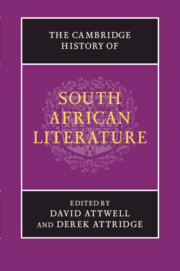Book contents
- Frontmatter
- Introduction
- PART I ORATURES, ORAL HISTORIES, ORIGINS
- PART II EXPLORATION, EARLY MODERNITY AND ENLIGHTENMENT AT THE CAPE, 1488–1820
- PART III EMPIRE, RESISTANCE AND NATIONAL BEGINNINGS, 1820–1910
- PART IV MODERNISM AND TRANSNATIONAL CULTURE, 1910–1948
- PART V APARTHEID AND ITS AFTERMATH, 1948 TO THE PRESENT
- 19 The fabulous fifties: short fiction in English
- 20 Writing in exile
- 21 Afrikaans literature, 1948–1976
- 22 Afrikaans literature after 1976: resistances and repositionings
- 23 The liberal tradition in fiction
- 24 Black Consciousness poetry: writing against apartheid
- 25 Popular forms and the United Democratic Front
- 26 Writing the prison
- 27 Theatre: regulation, resistance and recovery
- 28 The lyric poem during and after apartheid
- 29 Writing and publishing in African languages since 1948
- 30 Writing the interregnum: literature and the demise of apartheid
- 31 Rewriting the nation
- 32 Writing the city after apartheid
- PART VI SOUTH AFRICAN LITERATURE: CONTINUITIES AND CONTRASTS
- Index
- References
22 - Afrikaans literature after 1976: resistances and repositionings
from PART V - APARTHEID AND ITS AFTERMATH, 1948 TO THE PRESENT
Published online by Cambridge University Press: 28 January 2012
- Frontmatter
- Introduction
- PART I ORATURES, ORAL HISTORIES, ORIGINS
- PART II EXPLORATION, EARLY MODERNITY AND ENLIGHTENMENT AT THE CAPE, 1488–1820
- PART III EMPIRE, RESISTANCE AND NATIONAL BEGINNINGS, 1820–1910
- PART IV MODERNISM AND TRANSNATIONAL CULTURE, 1910–1948
- PART V APARTHEID AND ITS AFTERMATH, 1948 TO THE PRESENT
- 19 The fabulous fifties: short fiction in English
- 20 Writing in exile
- 21 Afrikaans literature, 1948–1976
- 22 Afrikaans literature after 1976: resistances and repositionings
- 23 The liberal tradition in fiction
- 24 Black Consciousness poetry: writing against apartheid
- 25 Popular forms and the United Democratic Front
- 26 Writing the prison
- 27 Theatre: regulation, resistance and recovery
- 28 The lyric poem during and after apartheid
- 29 Writing and publishing in African languages since 1948
- 30 Writing the interregnum: literature and the demise of apartheid
- 31 Rewriting the nation
- 32 Writing the city after apartheid
- PART VI SOUTH AFRICAN LITERATURE: CONTINUITIES AND CONTRASTS
- Index
- References
Summary
Literature and history
The aim of this chapter is to give a selective overview of Afrikaans literature after 1976. It is customary in South African literary historiography to accept that literary histories are shaped by contextual as well as aesthetic factors and to use historical transitions as reference points for the periodisation of literature. It has also been argued that ‘there is a growing consensus for a common periodization of contemporary South African literature which would use the dates of Sharpeville, Soweto, and the idea of the interregnum to guide the organisation of the field’ (Loflin, ‘Periodization in South African literatures’). This is confirmed by the general practice in Afrikaans literary historiography: Ampie Coetzee (Letterkunde en Krisis [Literature and Crisis], 1990) and J. C. Kannemeyer (Die Afrikaanse Literatuur 1652–2004 [Afrikaans Literature 1652–2004], 2005) as well as the writers of the overviews in the different volumes of the collaborative literary history Perspektief en Profiel (Perspective and Profile, 1998, 1999, 2005), edited by H. P. van Coller, use these dates as reference points in their description of Afrikaans literary history.
Afrikaans literature after 1976 can be divided into two phases, even though certain discontinuities and overlaps occur. The first phase starts in 1976 when the Soweto uprising against the enforced use of Afrikaans in schools signalled the beginning of a more concerted resistance against the apartheid government. The ensuing stigmatisation of Afrikaans deeply affected Afrikaans literature and led Afrikaans authors to comment on the compromised status of the language in which they wrote.
- Type
- Chapter
- Information
- The Cambridge History of South African Literature , pp. 452 - 473Publisher: Cambridge University PressPrint publication year: 2012
References
- 6
- Cited by

